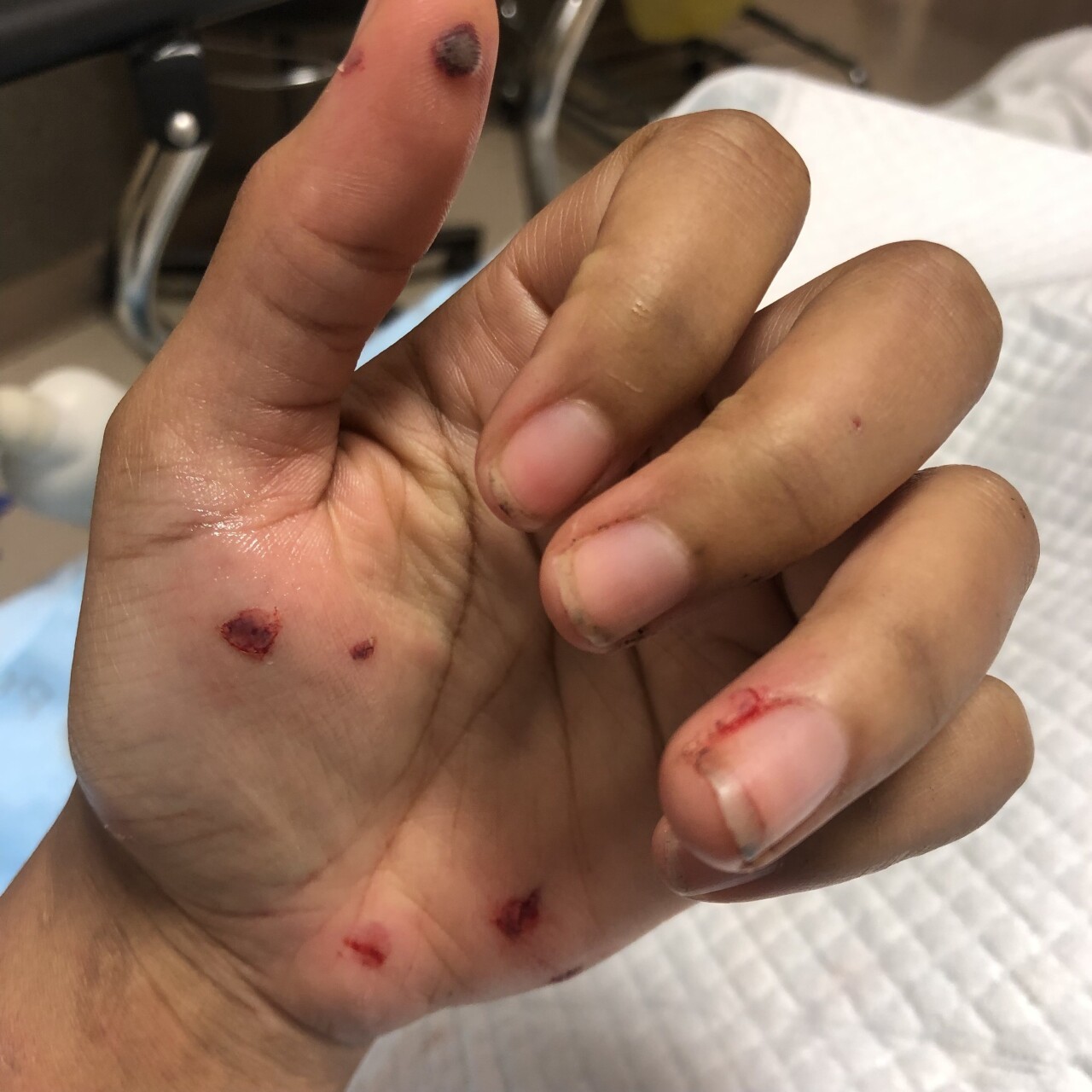CINCINNATI — When a dog named Kraven attacked a kennel technician at Hamilton County’s animal shelter in November, Dog Warden Troy Taylor intervened with a stun gun.
“Kraven let go and flew back a beat and yelped,” said Jane Collins, who was pulled to the ground by the 45-pound Terrier/pit bull. Collins was relieved that her screams brought Taylor’s help. But the dog “recovered quick. He shook himself off and before they could get in between him and me, he came right back at my arm. And harder,” she said.
The attack, which caused Collins to be hospitalized and Kraven to be euthanized, has been cited by several former employees as an example of safety problems at Cincinnati Animal Care, a nonprofit humane society that won a 2020 contract to operate the county’s animal shelter and dog warden program.

The WCPO 9 I-Team has been investigating those concerns because the agency has dramatically expanded the use of foster homes in Hamilton County to care for injured, neglected and unwanted pets.
Although it’s growing in popularity nationwide, the practice of fostering was less common when the Society for the Prevention of Cruelty to Animals served as Hamilton County’s dog warden prior to August 2020. But now, 350 cats and dogs are in foster care at any given time, said Meaghan Colville, director of life-saving operations at Cincinnati Animal Care.
“With any change in leadership, some people will like it, some won’t,” Colville said. “We’re handling animals. There’s going to be some bites. But they haven’t risen to the level of concern for us.”

Public records document changes
Health Department data from Cincinnati and Hamilton County show dog bites hit a four-year high of 980 in 2021, up 12.5% from 2019, the last full year in which the SPCA operated the county shelter. Cincinnati Animal Care said it’s not responsible for the increase of 109 bites. Its internal data shows only 32 reported dog bites among its foster-care placements last year, which is 0.9% of the animals it placed in such homes.
Hamilton County records show other significant differences between Cincinnati Animal Care and its predecessor:
- Cincinnati Animal Care received 69% more dogs (3,880) in 2021 than the 2,300 SPCA received in 2019, according to intake reports submitted to the county.
- Cincinnati Animal Care euthanized 87% fewer dogs (43 compared to 334) last year and returned 23% more dogs to owners (977 vs 793).
- Cincinnati Animal Care placed 2,009 dogs into adoption and reported 390 were “transferred to rescue” in 2021. Those categories did not appear in SPCA’s quarterly intake reports to the county in 2019.
- Hamilton County provided a history of dog warden “fines for section 955.21 and 955.22 processed via the Clerk of Courts.” It shows Cincinnati Animal Care generated $6,621 from its enforcement activity in 2021, down 38% from 2019, when SPCA handled enforcement matters for the county.
- Hamilton County paid Cincinnati Animal Care average monthly payments of $322,000 in the first 18 months of its contract, dropping to $250,000 in 2022. Both were well above the $151,080 per month that the county paid the SPCA in 2019, according to county contracts.
Two points of view
During a tour of the shelter, Cincinnati Animal Care demonstrated how its behavior training team evaluates dogs by walking them one at a time into a fenced play area and watching for signs of aggression, anxiety and other concerns. Colville said the nonprofit’s total employment has grown from 50 to 65, with five new hires on the way. Its medical staff has grown from three to 11 employees, while the behavior and foster teams have tripled to three employees each.
“The traditional way of animal sheltering is just blindly walking into an animal shelter that didn’t have a behavior team, didn’t have a foster team, didn’t have as many staff as we do here, didn’t have a volunteer program, and you just pick a dog and walk out the door with no information,” she said. “What we’re doing here is we’re trying to provide as much information as we can.”
Former employees paint a different picture.
"I saw far too many employees, volunteers, fosters and potential adopters bitten or attacked,” Deputy Dog Warden Gabriella Fulton wrote in a Dec. 14 resignation letter, obtained by the WCPO 9 I-Team in a public records request.
"New recruits are not being trained properly and it's only a matter of time before something bad happens,” Dog Warden Captain Brandon Corcoran wrote in his resignation letter Dec. 9.
Maris Schneeman, who resigned Dec. 23, told the I-Team she relocated to Cincinnati to work for Cincinnati Animal Care. But she couldn’t continue “after witnessing several extreme safety concerns for the staff and the public as well as neglectful treatment of the animals there. I unfortunately didn’t feel like this was going to be the right fit for me.”

Kraven's story
Collins reached the same conclusion after she returned to work one week after the attack and learned she was not the first to be bitten by Kraven. In the two months leading up to her attack, internal notes obtained by the I-Team and authenticated by Cincinnati Animal Care, showed the dog was returned to the shelter by five different foster homes. In the last incident Nov. 9, Kraven bit an owner who was trying to break up a fight between Kraven and another dog.
“And I’m kind of like, ‘Well, why didn’t you guys tell me that?’” Collins said. “I’ve been around dogs but I’m still new here. I’m still a newbie. I’m not going to feel comfortable just walking a dog that’s had a bite experience like that before.”

Cincinnati Animal Care defends its actions in the Kraven case, saying the dog gave it no indication it would attack the way it did on Nov. 29.
“He was skittish,” Colville said. “That’s kind of why he was on the radar. We knew he was a little bit nervous. But that’s not a death sentence. That doesn’t mean he’s going to bite."
Schneeman, who worked as a humane law enforcement officer for two years at Humane Rescue Alliance in Washington, D.C., said the shelter made several mistakes.
“There were no protocols in place. There was no training for her. There was no staff around. There should have been a walkie-talkie within reach,” Schneeman said. “The dog should have been on a catch pole.”
Animal trainers use long poles with a lasso at the end to catch and control aggressive animals. Schneeman said the tools are common in other shelters, but she’s never seen one at Cincinnati Animal Care. She also takes issue with Taylor’s use of a stun gun to end the attack.
“It’s completely improper protocol to tase an animal that’s biting somebody,” Schneeman said. “That animal would have bit down harder when tased, which it did. Released. And then proceeded to bite her other arm.”
Taylor did not return messages left for him through Media Relations Manager Ray Anderson, who questioned Schneeman's credibility.
"Miss Schneeman was on the way to being terminated when she resigned her position," Anderson said, citing "numerous performance issues" while declining to reveal details.
Colville said it was “Chief Taylor’s call” to decide the best way to get Collins to safety.
“It’s a high-level option, but that’s what he chose,” she said.
Colville said Cincinnati Animal Care made no policy changes after the incident.
Collins said she was initially grateful to be free of the dog. But now, she’s mostly annoyed that she was placed in such a dangerous situation. The shelter uses a color-coding system to let employees and volunteers know how safe it is to walk a dog. Green is the safest rating.
"He was green," Collins said. "Clean as a whistle."
Cincinnati Animal Care refuted Collins' claim that Kraven was 'green' after the publication of this story, saying that Kraven was yellow.
Collins said Kraven’s history – which she never saw until after the attack - points to increasing agitation by a dog that was bounced repeatedly from homes to the shelter.

According to the internal notes the I-Team obtained, Kraven was picked up as a stray on Oct. 4, and was labeled a “flight risk” after he “took three days to capture.” On Oct. 11, he was returned from a foster home for “just being too hyper.” On Nov. 1, he was returned for “separation anxiety and not getting along with owner’s cat.” On Nov. 9, Kraven “bit the foster” who tried to pull him out of a dog fight. And on Nov. 26, a staffer noted Kraven “can eat through a door and get out of any room.” Kraven attacked Collins three days later.
“He was anxious,” Collins said. “He was tired of going back and forth all the time. He was over-stimulated. And I just happened to be the one he blew up on.”
CORRECTIONS: An earlier version of this article mis-identified Collins' title and incorrectly stated Colville worked in animal care since 2017 not 2010.


